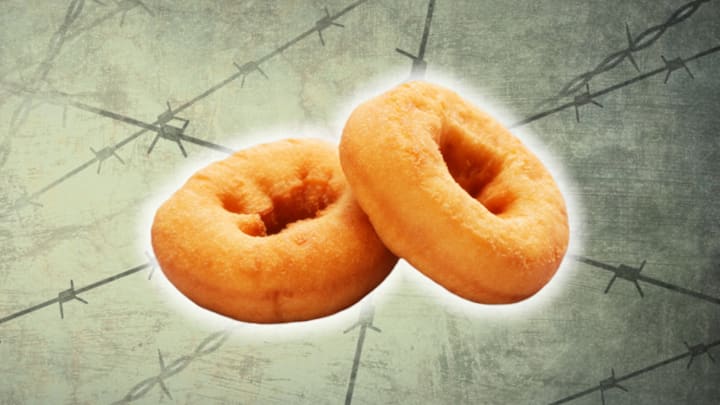If you’ve ever eaten a free doughnut on the first Friday in June, you’ve celebrated the Doughnut Lassies—whether you realized it or not. National Doughnut Day was established to honor the Salvation Army volunteers who fried sugary snacks for World War I soldiers on the front lines. Some Doughnut Lassies were even willing to risk their lives to provide that momentary morale boost. One story from The War Romance Of The Salvation Army (written by Evangeline Booth, daughter of the Salvation Army’s founders) describes a volunteer serving doughnuts and cocoa to a troop under heavy fire. When she was told by the regiment colonel to turn back, she responded, “Colonel, we can die with the men, but we cannot leave them.”
Frying on the Front Lines

The decision to serve doughnuts on the battlefield was partly a practical one. When the U.S. entered World War I in 1917, the Salvation Army, a Christian charity organization, sent roughly 250 volunteers (who were mostly women) to France, where American troops were stationed. The plan was to bring treats and supplies as close to the front lines as possible. But the closer the volunteers got to the action, the fewer resources they could access.
“It was difficult creating the pies and cakes and other baked goods they thought they might be making,” Lora Vogt, curator of education at the National WWI Museum and Memorial in Kansas City, Missouri, told Mental Floss in 2020. “Instead, they realized the doughnut was a very efficient use of both the time and the ingredient resources. And you could make thousands of doughnuts in a day to feed all the men serving.”
Ensign Margaret Sheldon and Adjutant Helen Purviance are credited with bringing doughnuts to the Western Front. They had a handful of ingredients at their disposal, including flour, sugar, lard, baking powder, and canned milk. Doughnuts were one of the few confections they could make without an oven, and once they had a fire hot enough to heat the oil, they could fry them up fast. The women had the pan to cook them in, but for other parts of the recipe, they had to get creative. In a pinch, grape juice bottles and even shell casings became rolling pins; an empty baking powder can became a doughnut cutter; and a tube that had come loose from a coffeemaker punched the holes.
Sheldon and Purviance's pan could fit seven doughnuts at a time, and on day one, they made just 150 doughnuts for the outfit of 800 men. Those who were lucky enough to grab a morsel were smitten, with one exclaiming “Gee! If this is war, let it continue!” according to The War Romance Of The Salvation Army. The salvationists fine-tuned their operation, and were eventually making 5000 doughnuts a day. The snacks were so beloved, the volunteers earned the nickname "Doughnut Lassies," while the soldiers they served were dubbed "Doughboys."
The All-American Doughnut
The Doughnut Lassies’s impact didn’t end with World War I. Prior to the war, Americans hadn’t fully embraced the doughnut. Dutch immigrants enjoyed doughnuts in the country for decades, but they weren’t considered an integrated part of American cuisine. It was the U.S. soldiers’s experience with doughnuts overseas that popularized them back home. “You have millions who are serving on the front lines who then have a really lovely association with the doughnut who may not have had one before,” Vogt said.
World War I also contributed to the doughnut's popularity in a less direct way. The treat appealed to U.S. bakers during wartime for the same reason the salvationists chose it: Recipes were adaptable and didn’t call for a ton of hard-to-source ingredients. “Crisco was putting out recipes for wartime doughnuts, and they suggested using Crisco as an alternative to lard because lard should be saved," Vogt said. "So you have this movement both on the front line and on the home front that let all Americans realize how delicious doughnuts could be.”
The Rise of National Doughnut Day

In 1938, the Salvation Army took advantage of its unofficial, sugary symbol and established National Doughnut Day to raise awareness of its charity work. Today, brands like Dunkin' and Krispy Kreme use the holiday as a marketing opportunity, but according to Vogt, the day is meant to be more about the Lassies’s service than the doughnuts they served. “National Doughnut Day is actually not about the doughnut. It is all about the Salvation Army volunteerism,” she said. “That concept of service and being able to share and build your community is part of what Doughnut Day is about.”
National Doughnut Day isn’t the only day dedicated to the treat in the U.S. A second National Doughnut Day falls on November 5, but the origins of that holiday aren’t as clear. If you want to enjoy some fried dough while commemorating a lesser-known part of World War I history, the first Friday in June—June 3, in 2022—is the day to remember.
A version of this article was originally published in 2020; it has been updated for 2022.
